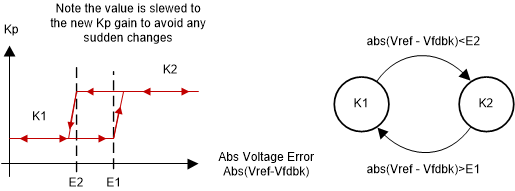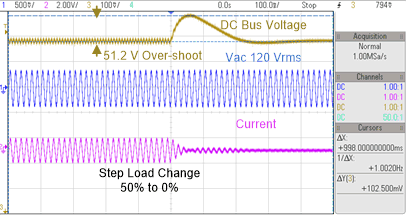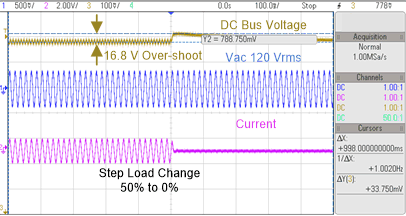TIDUD61E October 2020 – April 2021
- Description
- Resources
- Features
- Applications
- 5
- 1System Description
- 2System Overview
-
3Hardware, Software, Testing Requirements, and Test Results
- 3.1
Required Hardware and Software
- 3.1.1 Hardware
- 3.1.2
Software
- 3.1.2.1 Opening Project Inside CCS
- 3.1.2.2 Project Structure
- 3.1.2.3 Using CLA on C2000 MCU to Alleviate CPU Burden
- 3.1.2.4 CPU and CLA Utilization and Memory Allocation
- 3.1.2.5
Running the Project
- 3.1.2.5.1 Lab 1: Open Loop, DC (PFC Mode)
- 3.1.2.5.2 Lab 2: Closed Current Loop DC (PFC)
- 3.1.2.5.3 Lab 3: Closed Current Loop, AC (PFC)
- 3.1.2.5.4 Lab 4: Closed Voltage and Current Loop (PFC)
- 3.1.2.5.5 Lab 5: Open loop, DC (Inverter)
- 3.1.2.5.6 Lab 6: Open loop, AC (Inverter)
- 3.1.2.5.7 Lab 7: Closed Current Loop, DC (Inverter with resistive load)
- 3.1.2.5.8 Lab 8: Closed Current Loop, AC (Inverter with resistive load)
- 3.1.2.5.9 Lab 9: Closed Current Loop (Grid Connected Inverter)
- 3.1.2.6 Running Code on CLA
- 3.1.2.7
Advanced Options
- 3.1.2.7.1 Input Cap Compensation for PF Improvement Under Light Load
- 3.1.2.7.2 83
- 3.1.2.7.3 Adaptive Dead Time for Efficiency Improvements
- 3.1.2.7.4 Phase Shedding for Efficiency Improvements
- 3.1.2.7.5 Non-Linear Voltage Loop for Transient Reduction
- 3.1.2.7.6 Software Phase Locked Loop Methods: SOGI - FLL
- 3.2 Testing and Results
- 3.1
Required Hardware and Software
- 4Design Files
- 5Software Files
- 6Related Documentation
- 7About the Author
- 8Revision History
3.1.2.7.5 Non-Linear Voltage Loop for Transient Reduction
The PFC stage control is composed of an inner current loop, which tries to follow the input voltage and an outer voltage loop that tries to maintain a constant DC bus voltage at the output. The voltage loop is thus in conflict with the current loop and hence must be designed to be very low bandwidth (approximately 10 Hz) in order to achieve good power factor. The slow voltage loop results in significant overshoot and undershoot under transients (see Figure 3-59).
 Figure 3-59 Non-Linear Voltage Loop with Hysteresis
Figure 3-59 Non-Linear Voltage Loop with HysteresisTo improve voltage overshoot and undershoot, while maintaining good power factor a non-linear voltage control loop is implemented as shown in Figure 3-60. A hysteresis band is added in the non-linear voltage loop to avoid oscillation between high-gain and low-gain mode. Furthermore the gain change is slewed to avoid any sudden changes. Figure 3-61 shows the result with non-linear voltage loop.
 Figure 3-60 Voltage Transient Without Non-Linear Voltage Loop, Vin 120 Vrms, 880 W to 0 W Transient, Overshoot 51.2 V
Figure 3-60 Voltage Transient Without Non-Linear Voltage Loop, Vin 120 Vrms, 880 W to 0 W Transient, Overshoot 51.2 V Figure 3-61 Voltage Transient With Non-Linear Voltage Loop, Vin 120 Vrms, 880 W to 0 W Transient, Overshoot 16.8 V
Figure 3-61 Voltage Transient With Non-Linear Voltage Loop, Vin 120 Vrms, 880 W to 0 W Transient, Overshoot 16.8 VTo enable non-linear voltage loop, select the drop down box under Project Options on the powerSUITE page of the solution. Default value of five times the gain is applied for the proportional term under transient condition. This value can be adjusted under the <solution>_user_settings.h file by modifying the NON_LINEAR_V_LOOP_KP_MULTIPLIER define. The project must be saved, re-compiled, and loaded on the controller when this option is changed. Hardware setup and software instructions for the lab 4 can be followed to see the behavior of the board under transients.